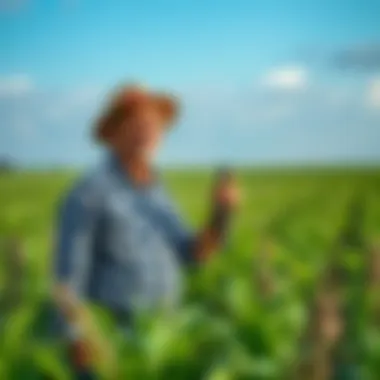Exploring the Lifecycle of Farmers: Stages and Challenges


Intro
Farming is not just a job; it’s a lifelong journey that shapes not only the lives of individuals but also the very fabric of society. This article seeks to unpack the multifaceted lifecycle of farmers, a process that intertwines personal commitment with broader agricultural innovations and traditions. With the world facing pressing challenges like climate change, food security, and dwindling natural resources, understanding the nuances of a farmer’s life has never been more critical.
From early beginnings rooted in tradition to modern methods aimed at sustainability, this exploration highlights the evolution of farming practices and the array of challenges farmers face today. It is essential to examine historical contexts to grasp the current realities and forecast future developments in agriculture. Through this lens, we can appreciate farmers not merely as producers but as custodians of our land and stewards of future generations.
Key Insights
Overview of the Topic
The lifecycle of farmers encompasses an extensive range of experiences and practices. It starts from the initial steps of land preparation and planting to advanced techniques that emphasize sustainability. As farmers grow, they often adapt to new challenges, such as changing economies, societal expectations, and environmental pressures. This holistic view is crucial for understanding the impact and relevance of farming today.
Importance in Agriculture/Horticulture/Agronomy
Farming is at the heart of agriculture, a sector that feeds our population and supports countless industries. As farmers navigate through their lifecycle, their decisions affect everything from local economies to global food supply chains. Recognizing their role helps underline the need for ongoing support, innovation, and education in agricultural practices.
Furthermore, the significance of sustainable practices cannot be overstated. They not only promise to conserve resources but also secure food production for the future.
Sustainable Practices
Eco-Friendly Techniques
Farmers today face a dual challenge: the urgent need to maximize yield while also maintaining environmental integrity. To meet this challenge, many have turned to eco-friendly techniques. These include practices like crop rotation, organic farming, and integrated pest management. Such methods not only enhance soil fertility but also ensure that the ecosystem remains balanced and productive. For example, cover cropping prevents soil erosion and contributes to soil health by naturally enriching it.
Case Studies on Sustainability
A closer look can illuminate the innovative approaches some farmers are implementing. In Oregon, a farmer transitioned to no-till farming techniques, which drastically reduced soil degradation while increasing crop yields. This shift didn’t only enhance productivity; it also garnered community support and improved local biodiversity. Another compelling example comes from South Africa, where farmers adopted agroforestry practices, resulting in a more resilient farming system that integrates trees and crops, providing multiple benefits such as improved soil health and habitat for wildlife.
Tools & Resources
Essential Equipment and Technologies
Today's farmers have access to groundbreaking technology that can facilitate various aspects of farming. Precision agriculture tools, for instance, allow farmers to assess field variability and optimize inputs accordingly. Drones are increasingly used for crop monitoring, enabling timely interventions that can enhance productivity. Not to mention, irrigation technology has advanced so far that it can save precious water resources while maximizing crop yield.
Recommended Books and Readings
For those looking to dive deeper into the intricacies of farming and sustainable practices, here are some valuable resources:
- "The Omnivore's Dilemma" by Michael Pollan – This book delves into the complexities of food systems and farming methods.
- "Sustainable Agriculture: A Comprehensive Approach" by Mark Van Horn – A detailed guide on various sustainable techniques.
- U.S. Department of Agriculture (USDA) resources available at www.usda.gov provide up-to-date research and statistics on farming practices.
It’s imperative to consider these resources as part of a lifelong learning journey for those in the agricultural sector.
Ending
In summation, comprehending the lifecycle of farmers is enthralling and necessary in modern times. Their experiences forge a path toward sustainable and responsible agricultural practices that can secure our food systems for the future. As this exploration unfolds, we will dive into specific challenges and inspire discussions that drive innovation and commitment across the farming community.
"Farmers are the backbone of our food system; understanding their journey is essential to nourish the future."
Understanding the Role of Farmers in Society
Farmers occupy a pivotal space in the fabric of society, nurturing not only our bodies through the food they produce but also sustaining the culture of community through their practices and ways of life. In this era where urbanization is rampant, the farmer's role often gets overshadowed; yet, their contributions are as crucial as ever. The importance of understanding their roles encompasses a variety of elements that deal with history, economics, and social dynamics. Each of these aspects intertwines to form a portrait of what it means to be a farmer today.
Historical Significance
To grasp the full significance of farmers in society, one must journey back in time. Historically, farmers have been the backbone of civilizations, laying the groundwork for societal advancement. For example, during the Agricultural Revolution, transitioning from nomadic lifestyles to settled farming communities drastically changed human history. It marked the beginning of urbanization, trade, and the establishment of social hierarchies. Without the agricultural skills honed through generations, our current society would lack the complex structures of trade and governance that have arisen since.
The notion of land ownership, for instance, has evolved dramatically from communal practices shared by all villagers to private lands cultivated by individual farmers. This historical shift not only shaped society but also defined wealth distribution and power dynamics across continents. Farmers have influenced cultures through festivals celebrating harvests, the dissemination of traditional recipes, and even their involvement in local governance. To this day, many still find themselves at the heart of local customs and traditions.
Modern Agricultural Practices
Today, farming is not just about plowing fields and harvesting crops; it’s a multifaceted industry that embraces science, technology, and new methodologies. Modern agricultural practices have ushered in innovative techniques like precision farming, drones, and genetically modified organisms. These advancements not only boost yield but also promote sustainability, setting the stage for future generations of farmers.
For instance, precision agriculture allows farmers to monitor their crops' health and productivity through satellite imaging and sensors. This means they can apply resources like water, fertilizers, and pesticides more efficiently, minimizing waste and reducing costs.
Moreover, the integration of technology in farming has made significant strides toward eco-friendly practices. Many farmers are now employing sustainable methods such as crop rotation and organic farming, preserving soil health while meeting the rising demands of a growing population. These modern shifts don’t just benefit the farmers but also serve the broader community by ensuring food security.
The Path to Becoming a Farmer
The journey to becoming a farmer is not just a career choice; it’s a commitment that begins long before one sets foot on the fertile soil. This path is intricate, combining education, real-life experiences, and an understanding of the land. It is a multifaceted adventure that requires a unique blend of passion, knowledge, and resilience. As farming becomes increasingly sophisticated, understanding how to navigate this path can lead to better outcomes not just for the farmer but for the communities they serve.
Educational Background
A solid educational foundation serves as the bedrock for aspiring farmers. Farming today goes beyond mere planting and harvesting; it encompasses understanding advanced agricultural practices, business management, and environmental stewardship. Many universities offer programs specifically tailored to agricultural sciences. Students delve into subjects ranging from soil chemistry to pest management and even the economics of farming. Some notable programs can be found at institutions such as the University of California, Davis or Cornell University, where the blend of theoretical knowledge and practical experience is emphasized.
In addition, community colleges provide accessible options for those seeking vocational training in agriculture. These programs often focus on hands-on skills required for operating modern farm equipment or managing livestock. Furthermore, many farmers find it beneficial to pursue certifications in sustainable farming practices or organic agriculture, which can enhance their marketability.


However, while formal education is significant, it is only the first step. A farmer’s grasp of local ecosystems and weather patterns, for instance, often comes from years of observing their surroundings. It’s essential to note that every piece of knowledge gathered in classrooms is invaluable, but nothing quite enhances understanding like being out in the field.
Hands-on Experience
Nothing compares to the education gained through direct involvement in farming. This experience is often informal but immensely valuable. Many young farmers start their journeys by assisting family members or local farmers, learning the ropes through sweat and dedication. One might say it’s the best way to learn the trade—through the good, the bad, and the sometimes muddy.
During these formative years, various skills develop naturally, such as how to operate machinery, manage crops, and solve problems on the fly when things don't go as planned. This practical knowledge equips them for the challenges farmers face daily, from unexpected weather shifts to market fluctuations.
Moreover, internships and apprenticeships at established farms can provide crucial insights into advanced farming techniques. Participants can explore innovative approaches like permaculture or aquaponics, which are becoming more relevant in today's environmentally-conscious market. Networking with other farming professionals during these experiences also opens doors to mentorship and collaboration opportunities, helping one grow both personally and professionally.
"The best way to learn about farming is not just from books, but through a good shovel and a lot of soil on your boots."
Ultimately, the path to becoming a farmer weaves together formal education and real-world experience. Together, they shape an individual who is not only adept in the field but also prepared mentally to tackle the various challenges of the agricultural sector. It's this blend of learning that can distinctly set apart a successful farmer in today’s complex and ever-evolving landscape.
Daily Life of a Farmer
The daily life of a farmer is far from simple; it embodies a deeply rooted connection to the land and an unwavering commitment to nurturing it. This section digs into what farmers do each day, highlighting their routines, responsibilities, and the rhythm of their lives in sync with nature. Understanding these day-to-day activities provides insight into the significant role farmers play not just in agriculture but in society as a whole. The consistency in their routines builds resilience, while the variability depending on season and circumstance invites adaptability and innovation.
Routines and Responsibilities
Routines among farmers often begin before dawn when the world is quiet, and the only sounds are the gentle rustle of leaves and the distant crowing of a rooster. Farmers rise early, often fueled by the desire to make the most of the sunlight, which is a precious resource. Morning chores might include feeding livestock, tending to crops, and checking equipment, all before breakfast. This period is crucial; every task performed quietly lays the groundwork for a productive day.
A farmer’s responsibilities can vary wildly depending on the season and types of crops grown. For instance, during planting season, a farmer might engage in activities such as selecting seeds, preparing the soil, and using machinery to plant crops with precision. As crops develop, the focus shifts to maintenance—watering plants, applying fertilizers, and managing pests. As such, farmers often wear many hats, shifting from an agronomist to a mechanical expert and even a business strategist. Each role is critical to the overarching goal: maintaining a healthy yield.
"Farming is not just a job; it's a lifestyle that requires passion, hard work, and a willingness to adapt to nature’s whims."
Aside from physical labor, farmers are tasked with logging far more hours than the average worker. Administrative responsibilities like bookkeeping, maintaining equipment records, and planning for future seasons demand a keen mind and exceptional organizational skills. It’s this blend of physical and intellectual work that set farmers apart. Their dedication fuels the backbone of local and global food systems, making them vital contributors to our wellbeing.
Seasonal Variations
Seasonal variations can dramatically shift a farmer's workload and responsibilities. Here's a glimpse into how these changes unfold throughout the year:
- Spring and Planting Season: This is perhaps the busiest time of year. Farmers scramble to prepare fields, select and plant crops, and ensure all systems are ready for the upcoming months. The planting season typically sees heightened activity, familial cooperation, and even community involvement in order to complete strenuous tasks in a short window.
- Summer and Growing Season: Once the seeds are planted, day-to-day routines settle slightly, with more emphasis on maintenance than initial planting. Farmers monitor crop growth closely, doing their best to combat issues like drought or pests. Many also take advantage of community markets during summer, showcasing their harvest alongside other local producers.
- Fall and Harvest Season: Fall marks another crucial time rife with activity. With crops ready for harvest, farmers find themselves in a race against time, needing to gather produce before the first frost. This period often means longer hours and working alongside family and friends who lend a hand. Celebrations often follow, with harvest festivals in communities across rural landscapes.
- Winter and Preparation: In winter, farmers take a breath. Though it seems a quieter time, many use this period to plan for the next year, attend workshops, and stay informed about new agricultural technologies and sustainable practices. This is also the time for maintenance of tools and equipment, ensuring everything is ready when the earth thaws and planting begins anew.
By understanding these seasonal changes, readers gain valuable insight into how farmers adapt their routines to accommodate nature’s influences while also keeping the economic pressures of agriculture at the forefront. The cycle of farming reflects life’s broader rhythms, yielding lessons in patience, planning, and perseverance.
Navigating Challenges in Agriculture
Farming today isn’t just about planting seeds and waiting for rain. It’s a complex dance where countless factors need careful consideration. As the global population swells, farmers find themselves navigating a minefield of challenges that can impact their livelihoods and the food supply for millions. This section will delve into three primary challenges that farmers face daily: economic pressures, climate change impacts, and the rapidly evolving technological landscape.
Economic Pressures
The wallet can be a farmer's fiercest adversary. Economic pressures come in many forms—fluctuating market prices, rising input costs, and shifts in consumer demand. For instance, a farmer growing corn may find themselves in a pinch if the market price tumbles, making it tough to break even after considering expenses like seeds, fertilizers, and labor. Each season, farmers brace themselves for the unknown, mapping out strategies that might help them weather financial storms.
Key Aspects of Economic Pressures:
- Market Volatility: Local and global market shifts can dramatically alter a farmer's revenue.
- Input Costs: Prices for seeds, fuel, and equipment are often on the rise.
- Debt Load: Many farmers operate on loans, making them vulnerable to adverse conditions.
"The life of a farmer can sometimes feel like a game of poker; if the cards don't play out well, it can cost you big time."
Climate Change Impacts
The climate crisis is not just a trending topic; it’s a reality that many farmers are grappling with. Shifting weather patterns, unexpected droughts, and increasingly severe storms create an unpredictable environment for agriculture. Farmers who once relied on seasonal patterns to plan their crops now find themselves adapting to inconsistent rainfalls and prolonged dry spells. The significance becomes apparent as crop yields fluctuate, directly impacting food availability and prices.
Effects of Climate Change on Farming:
- Altered Growing Seasons: Changes in temperature can lead to shorter or longer growing seasons, affecting yield.
- Soil Degradation: Extreme weather can erode topsoil and disrupt the delicate balance of soil nutrients.
- Pest and Disease Proliferation: Warmer temperatures can lead to more pests and diseases, putting even more pressure on farmers.
Technological Changes
In this day and age, staying up to date with technology is not just a bonus but a necessity. From advanced irrigation systems to precision agriculture that utilizes GPS technology, farmers have a plethora of tools at their disposal. However, keeping pace with these changes can be difficult—especially when considering the cost of implementation and the learning curve associated with new machinery. Embracing innovation isn't just about reducing labor; it's often a crucial step in increasing productivity and sustainability.
Critical Technological Advances:
- Precision Agriculture: Using data and analytics to maximize yields and minimize waste.
- Biotechnology: Developing crop varieties that are more resilient to stress.
- Automation: Machine learning and robots that aid in planting, harvesting, and monitoring.
In sum, the challenges farmers face are numerous and multifaceted. The agricultural landscape is constantly changing, and farmers must adapt to survive. By understanding the economic pressures, climate impacts, and technology-driven solutions, farmers can develop strategies that not only support their livelihood but also contribute to the greater good of food security and sustainability.
Sustainability and Innovation
Sustainability and innovation are two sides of the same coin in today’s frantic agricultural environment. It’s not just about growing food, but about growing it in a way that preserves the land for future generations. The pressures of climate change and an ever-growing population push farmers to rethink age-old practices. This section aims to connect the dots between sustainable practices and innovative techniques that are imperative for survival and prosperity in modern farming.
Adoption of Sustainable Practices
Employing sustainable practices represents a shift from traditional farming methods, often resembling a tightrope walk between productivity and ecological responsibility. Farmers today are increasingly adopting techniques that not only boost yields but also safeguard the environment.


For instance, crop rotation has gained traction as a reliable method. By alternating the types of crops grown, farmers can reduce soil depletion and combat pests naturally. This simple yet effective method minimizes the need for chemical fertilizers and pesticides, fostering healthier soil and producing better quality crops.
Another prominent sustainable practice is integrated pest management. Rather than carpet-bombing fields with chemicals, farmers harness natural pest predators, reducing harmful chemical usage. Some farmers even share resources and knowledge through local cooperatives, making sustainable practices more accessible. As community friendships build over time, this sharing fosters a collective commitment to sustainability. Drawn into this circle of innovation, farmers encourage each other to explore new techniques and technologies, creating a dynamic network of environmentally conscious growers.
Pros and Considerations
- Environmental Benefits: Reduced chemical use enhances biodiversity.
- Cost Efficiency: Sustainable practices can lower operating costs in the long run, as they reduce dependency on external inputs.
- Market Advantage: Growing interest in organic and locally sourced food means farmers who adopt these practices can tap into premium price markets.
However, making the switch isn’t without its challenges. Farmers encounter the initial costs of implementing new equipment or practices, which can feel overwhelming when margins are tight. Plus, the learning curve for these innovative techniques can require a significant time investment.
"Sustainability isn't just a buzzword; it's a way of life for forward-thinking farmers."
Innovative Techniques in Farming
As the old adage suggests, “what got you here won’t get you there.” The world of agriculture is evolving, and farmers are seizing new technologies to boost efficiency and sustainability.
From vertical farming to hydroponics, farmers are carving out creative paths to maximize their yields. Vertical farming allows for the cultivation of crops in stacked layers, making effective use of space in urban areas. This not only net gains in production but also reduces the need for pesticides and fertilizers through controlled environments.
Then, there’s precision agriculture. This high-tech approach capitalizes on data analytics, utilizing GPS and sensors in the field to monitor crop health and manage resources efficiently. By applying the right amount of water and nutrients exactly where they're needed, farmers minimize waste while optimizing crop performance.
Why It Matters
- Resource Conservation: Reducing water and nutrient runoff helps protect our ecosystem.
- Higher Yields: Methods like hydroponics often lead to increased production in smaller spaces, addressing food scarcity issues.
- Climate Resilience: Innovative techniques can lead to more resilient farming practices, allowing crops to adapt better to shifting weather patterns.
In summary, embracing sustainability and innovation isn’t just a trend; it’s a necessity for the future of agriculture. Farmers who adapt to these practices and techniques not only thrive but also contribute significantly to the health of the earth and the future of food production.
To explore more about sustainable agriculture, check out resources from Wikipedia or the USDA.
The Future of Agriculture
The landscape of agriculture is experiencing a radical transformation. As society grabbles with issues from climate change to food security, the future of agriculture holds critical importance. This section examines how farmers can adapt to shifting paradigms while embracing innovation and sustainability in their practices. The need for new strategies, technologies, and policies cannot be overstated; the stakes are high, and the time to invest in the future is now.
Trends Affecting the Industry
Several key trends are reshaping the world of agriculture, directly influencing how farmers operate:
- Precision Farming: This approach leverages technology and data analytics to enhance crop yield and efficiency. Using GPS, drones, and sensors, farmers can make informed decisions that reduce waste and optimize resources.
- Urban Agriculture: As populations rise in urban areas, integrating farming into cities becomes essential. Vertical farms and rooftop gardens are examples that allow residents to grow produce in limited spaces, reducing the carbon footprint associated with transporting food.
- Biotechnology: Genetic engineering is becoming more commonplace. Crops redesigned for better resilience to pests, diseases, and climate change are crucial for ensuring food security. However, ethical considerations and public acceptance remain hot topics in this discourse.
- Local Sourcing: Many consumers prefer buying locally produced goods. This trend not only supports local economies but also minimizes transportation, leading to a smaller environmental impact.
"Understanding these trends is essential for farmers who want to stay viable in a rapidly changing market."
Adapting to these trends requires awareness and readiness. Farmers will need to embrace these shifts to remain competitive and sustainable.
The Role of Policy and Legislation
Policies and legislation can either bolster or hinder farmers' progress toward a sustainable future. Key aspects to consider include:
- Subsidies and Incentives: Governments often provide financial support for eco-friendly practices. Programs that promote sustainable farming practices or renewable energy can encourage farmers to adopt greener methods.
- Regulations: Striking a balance between supporting agricultural innovation and ensuring food safety is necessary. Regulations regarding pesticide use, GMO crops, and water rights will shape the farming landscape in the coming years.
- Climate Agreements: International agreements aimed at curbing climate change will influence how farmers manage their land and resources. Farmers who can align with these initiatives may unlock new funding streams and markets for their produce.
- Research Funding: Supporting agricultural research is vital for developing new technologies and solutions. Government investment in agricultural research institutions can yield breakthroughs in crop resilience, pest management, and soil health.
The Emotional and Social Aspects of Farming
Farming is much more than just a profession; it's a way of life deeply woven into the fabric of communities. Understanding the emotional and social dimensions of farming provides invaluable insights into the resilience and commitment of those who are dedicated to this vital sector. This section delves into the significance of community building and mental health considerations, illustrating how they are intertwined with the farmer's journey.
Community Building
Community is the backbone of agricultural life. Farmers often share resources, tools, and knowledge, which fosters a sense of belonging among them. Local farmers' markets become bustling hubs of commerce and camaraderie, where stories are exchanged over fresh produce. These gatherings are not just about selling or buying; they are about connection.
- Collaboration: Farmers frequently work with local organizations to amplify their efforts, from co-ops to active participant groups. Collaborations can lead to improved crop yields and better practices, creating a stronger economy.
- Support Networks: In many rural areas, farmers rely on each other for support during challenging times, such as poor harvests or equipment failures. Whether it is a quick chat over a fence or organized support during crises, such networks help to bolster morale.
- Cultural Events: Agricultural fairs and community festivals give farmers an opportunity to showcase their work and celebrate their heritage. These events instill pride and strengthen community ties as attendees celebrate locally produced goods.
Communities serving as support systems help create networks of resilience that enable farmers to navigate challenges together.
Mental Health Considerations
Life on the farm can often be solitary, leading to unique mental health challenges. The pressures of unpredictability in weather or market conditions can weigh heavily on a farmer's mind. Addressing mental health is essential not just for individual well-being, but for the health of the entire farming community.
- Awareness: There's a growing recognition of mental health in agriculture. Farmers are becoming more aware of these issues thanks to outreach by mental health organizations and agricultural extension services. This awareness opens doors to conversations and reduces stigma.
- Resources: Programs aimed at mental health support, including counseling and crisis intervention, have begun to emerge. Initiatives like the National Farmer’s Mental Health Alliance provide resources tailored to the unique stresses faced by farmers.
- Coping Strategies: Many farmers find solace in connecting with nature, engaging with peers, or participating in local initiatives that improve mental well-being. Simple activities like taking a walk in the fields can provide a much-needed respite from day-to-day stresses.
In summary, the emotional and social aspects of farming are critical to understanding the broader landscape of agriculture. Community building fosters connections that empower farmers, while addressing mental health issues brings necessary attention to what can be an isolated and stressful profession. Together, these elements form a holistic perspective that recognizes the various facets of the uniquely intricate lifestyle of farmers.
For further detail, consider exploring resources on mental health in agriculture at National Institute of Mental Health or community engagement strategies at Community Tool Box.
Economic Contributions of Farmers
Understanding the vital economic contributions of farmers unveils the backbone of both local and global economies. Farmers not only serve as the primary producers of food, fiber, and other essential materials, but they also play a critical role in sustaining rural communities and fostering economic development. The lifeblood of the agricultural sector lies in the contributions made by farmers, impacting everything from local shopkeepers to international trade agreements.
Local Economies


Farmers are the driving force behind local economies, significantly influencing employment rates and economic growth in rural areas. Their activities provide jobs directly through farming, and indirectly by supporting numerous ancillary businesses such as equipment suppliers, feed manufacturers, and transportation services. The money spent by farmers in their communities—purchasing groceries, repairing machinery, and maintaining homes—circulates within the local economy, enhancing its vitality.
For example, consider a small town surrounded by vast farmlands. The local diner thrives on the business from farmers who pop in for breakfast after an early morning milking session. Farmers shop at the local grocery store for staples, usually filling their carts after a long day in the fields. This flow of cash prevents rural communities from drying up economically and increases the local standard of living.
Not to forget, farmers often support local schools and charities. They contribute produce for community events or sponsor sports teams. It's not just about numbers; it's about connection to the land and local culture—the farmer easily shifts from producing corn to supplying pumpkins for the fall festival. Such actions strengthen community ties and create a sense of belonging.
Global Agriculture Market
On a larger scale, farmers contribute significantly to the global agriculture market. The agricultural sector is one of the most critical components of international trade, with farmers around the world supplying food products to meet the demands of a burgeoning global population. Reports suggest that global agricultural exports account for a considerable percentage of total trade, often driving national economies.
When a farmer in the Midwest grows soybeans, they are part of a supply chain that might stretch to Asia, where those soybeans could become feed for livestock. This interconnectedness implies that changes in local farming practices can ripple through global economic systems. Factors such as weather patterns, commodity prices, and international trade agreements can affect not just profits but also food security both locally and abroad.
In essence, the contributions of farmers extend far beyond their individual farms. They link communities and countries, ensuring that trade flows smoothly across borders while keeping local economies buoyant.
"Farmers are the silent guardians of our food supply, operating at the crossroads of local needs and global markets."
To delve deeper into the intricacies of local economies and global markets, one can visit resources such as the U.S. Department of Agriculture and Food and Agriculture Organization of the United Nations.
Understanding the nuanced financial responsibilities and potential challenges of farmers sheds light on the complexities of their economic contributions and the sustainability of agriculture as a whole.
Agricultural Education and Training
Agricultural education and training play a crucial role in shaping the future of farming. As the agricultural landscape evolves with new technologies, changing market demands, and environmental considerations, the need for well-informed farmers has never been more pressing. This segment of the farming lifecycle emphasizes the significance of education — both formal and community-based — in fostering a competent and adaptable farming workforce.
Formal Education Programs
Delving into formal education, many institutions offer degree programs that equip aspiring farmers with a blend of theoretical knowledge and practical skills. From agricultural science to agronomy, these programs often cover a variety of subjects like soil science, crop management, and agricultural economics. Such a foundation prepares students not just to cultivate crops but to understand the broader agricultural system in which they operate.
Moreover, these programs frequently include internship opportunities. For instance, students at California State University, Fresno can gain hands-on experience through partnerships with local farms. This exposure helps students bridge the gap between classroom learning and real-world applications, making them more than just book-smart.
Formal education can also pave the way to advanced roles within the sector. Graduates can find positions in research, policy-making, or agricultural extension services. The agricultural industry benefits immensely from knowledgeable individuals who can drive innovation, support sustainable practices, and effectively communicate the importance of agriculture to the general public.
Community Workshops and Resources
On the other hand, community workshops and resources provide essential training tailored to farmers who may not have access to formal education. These workshops are often designed to address immediate concerns such as pest management, soil health, and organic farming practices. They are often organized by local agricultural extensions or non-profit organizations dedicated to agricultural advancement.
For instance, the University of Florida's Institute of Food and Agricultural Sciences regularly holds workshops in farming communities, covering practical topics like efficient irrigation techniques or the latest in crop disease management. These sessions not only impart valuable information but also foster a sense of community among the participants, enabling farmers to share their experiences and learn from one another.
In addition, online resources have emerged as a complement to traditional training. Websites such as eXtension.org provide webinars and articles on a myriad of topics. This can be especially beneficial for farmers looking to improve specific areas of their operations or explore new trends in agriculture.
"Education is the most powerful weapon which you can use to change the world." – Nelson Mandela
This quote resonates deeply within the agricultural community, as education is instrumental in enabling farmers to face challenges head-on.
Through both formal and community-based educational avenues, farmers are better equipped to make informed decisions, adapt to new practices, and contribute to the sustainability of agriculture. This awareness is critical not only for individual success but also for the collective evolution of the agricultural sector.
Building a Sustainable Future
When discussing the lifecycle of farmers, the topic of building a sustainable future cannot be understated. This subject is essential in addressing various challenges farmers face today. Sustainability means not just maintaining productivity but enhancing the health of the environment and the economy. It requires farmers to think about their practices and how they can contribute to a healthier planet while still supporting their families and communities.
Key Elements of Sustainable Farming
Building a sustainable future involves multiple facets:
- Resource Conservation: Efficient use of water, soil, and energy ensures that these vital elements are available for future generations.
- Diversified Cropping Systems: Growing a variety of crops can better endure climate changes and pest issues.
- Holistic Approaches: Farmers are adopting practices that consider the whole ecosystem rather than just their individual fields.
Each of these elements contributes to a robust framework that facilitates not only agricultural success but also environmental resilience.
Benefits of Sustainable Practices
The benefits of sustainable farming go beyond just the immediate harvest. They include:
- Improved Soil Health: Healthy soil leads to better crop yields. Practices such as crop rotation and cover cropping can rejuvenate tired soils.
- Enhanced Biodiversity: Sustainable farms typically support more varied ecosystems, which can lead to fewer pest problems and more reliable yields.
- Economic Viability: By reducing reliance on costly chemical inputs and increasing efficiency, farmers can enhance their profit margins over time.
It's clear that the transition to sustainable farming is not merely an option; it is a necessity for the longevity of agriculture and food security worldwide.
Promoting Eco-Friendly Practices
The journey to a sustainable future begins with the adoption of eco-friendly practices. This means utilizing methods that minimize harmful impacts on the environment. Farmers today are increasingly aware that their actions can have long-reaching consequences.
For example, integrating agroforestry—where trees and shrubs are used alongside crops—can promote higher yields and provide better habitats for wildlife. Moreover, reducing chemical pesticides through biocontrol methods not only cuts costs but also benefits consumers who prefer cleaner produce.
In a nutshell, promoting eco-friendly practices helps to establish a balance. It fosters healthier ecosystems, mitigates against climate change, and often leads to better financial outcomes for farmers.
Engaging with Local Ecosystems
Farming does not happen in isolation; it is part of a larger network of interactions within local ecosystems. Engaging with these systems means understanding how local environmental conditions influence farming choices and practices.
A significant step in this engagement is the relationship between farmers and the natural wildlife around their farms. For instance, creating habitats for pollinators like bees and butterflies can lead to improved crop yields.
Furthermore, utilizing permaculture principles where farmers design their lands mimicking natural ecosystems can greatly enhance sustainability. This not only helps in preserving biodiversity but also builds resilience against pests and diseases, creating a more self-sufficient farming operation.
"The future of agriculture is not about precision farming; it's about precision understanding of the environment we work in."
For further insights on sustainable practices, consider visiting resources such as USDA or National Sustainable Agriculture Coalition.
By embracing sustainability, we can work towards a farming future that protects both the environment and our food systems.







